Qantas Airways Strategic Leadership and Analysis Report
VerifiedAdded on 2022/09/02
|11
|3194
|48
Report
AI Summary
This report provides a comprehensive analysis of Qantas Airways, Australia's flag carrier. It begins with an overview of Qantas's background and then delves into its social responsibility and managerial ethical practices, examining their impact on stakeholders. The report then proceeds with a PESTLE analysis, identifying key political, economic, social, technological, legal, and environmental factors influencing the airline. Porter's Five Forces are used to assess the competitive landscape. An internal analysis explores Qantas's resources, capabilities, core competencies, and value chain, leading to an assessment of its competitive advantage. The report also examines the strategic competitiveness of Qantas and concludes with an analysis of the leadership and core competencies of Alan Joyce, a significant CEO in Qantas's history, and how his leadership has affected the strategy of the organization. The report uses various academic sources to support its findings and analysis.

qwertyuiopasdfghjklzxcvbnmqw
ertyuiopasdfghjklzxcvbnmqwert
yuiopasdfghjklzxcvbnmqwertyui
opasdfghjklzxcvbnmqwertyuiop
asdfghjklzxcvbnmqwertyuiopasd
fghjklzxcvbnmqwertyuiopasdfgh
jklzxcvbnmqwertyuiopasdfghjkl
zxcvbnmqwertyuiopasdfghjklzxc
vbnmqwertyuiopasdfghjklzxcvb
nmqwertyuiopasdfghjklzxcvbnm
qwertyuiopasdfghjklzxcvbnmqw
ertyuiopasdfghjklzxcvbnmqwert
yuiopasdfghjklzxcvbnmqwertyui
opasdfghjklzxcvbnmqwertyuiop
asdfghjklzxcvbnmqwertyuiopasd
fghjklzxcvbnmqwertyuiopasdfgh
jklzxcvbnmrtyuiopasdfghjklzxcv
Management
ertyuiopasdfghjklzxcvbnmqwert
yuiopasdfghjklzxcvbnmqwertyui
opasdfghjklzxcvbnmqwertyuiop
asdfghjklzxcvbnmqwertyuiopasd
fghjklzxcvbnmqwertyuiopasdfgh
jklzxcvbnmqwertyuiopasdfghjkl
zxcvbnmqwertyuiopasdfghjklzxc
vbnmqwertyuiopasdfghjklzxcvb
nmqwertyuiopasdfghjklzxcvbnm
qwertyuiopasdfghjklzxcvbnmqw
ertyuiopasdfghjklzxcvbnmqwert
yuiopasdfghjklzxcvbnmqwertyui
opasdfghjklzxcvbnmqwertyuiop
asdfghjklzxcvbnmqwertyuiopasd
fghjklzxcvbnmqwertyuiopasdfgh
jklzxcvbnmrtyuiopasdfghjklzxcv
Management
Paraphrase This Document
Need a fresh take? Get an instant paraphrase of this document with our AI Paraphraser
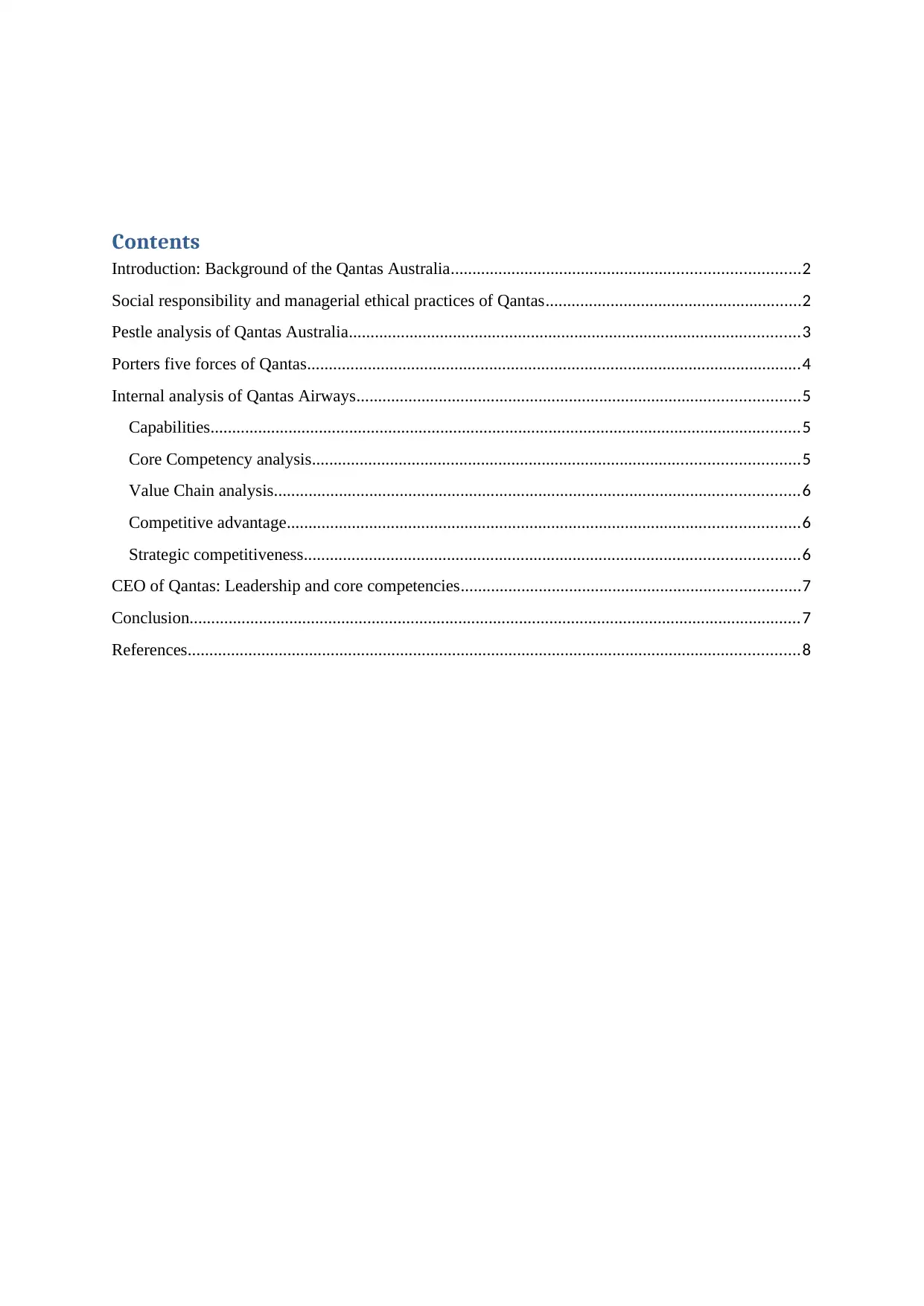
Contents
Introduction: Background of the Qantas Australia................................................................................2
Social responsibility and managerial ethical practices of Qantas...........................................................2
Pestle analysis of Qantas Australia........................................................................................................3
Porters five forces of Qantas..................................................................................................................4
Internal analysis of Qantas Airways......................................................................................................5
Capabilities........................................................................................................................................5
Core Competency analysis................................................................................................................5
Value Chain analysis.........................................................................................................................6
Competitive advantage......................................................................................................................6
Strategic competitiveness..................................................................................................................6
CEO of Qantas: Leadership and core competencies..............................................................................7
Conclusion.............................................................................................................................................7
References.............................................................................................................................................8
Introduction: Background of the Qantas Australia................................................................................2
Social responsibility and managerial ethical practices of Qantas...........................................................2
Pestle analysis of Qantas Australia........................................................................................................3
Porters five forces of Qantas..................................................................................................................4
Internal analysis of Qantas Airways......................................................................................................5
Capabilities........................................................................................................................................5
Core Competency analysis................................................................................................................5
Value Chain analysis.........................................................................................................................6
Competitive advantage......................................................................................................................6
Strategic competitiveness..................................................................................................................6
CEO of Qantas: Leadership and core competencies..............................................................................7
Conclusion.............................................................................................................................................7
References.............................................................................................................................................8
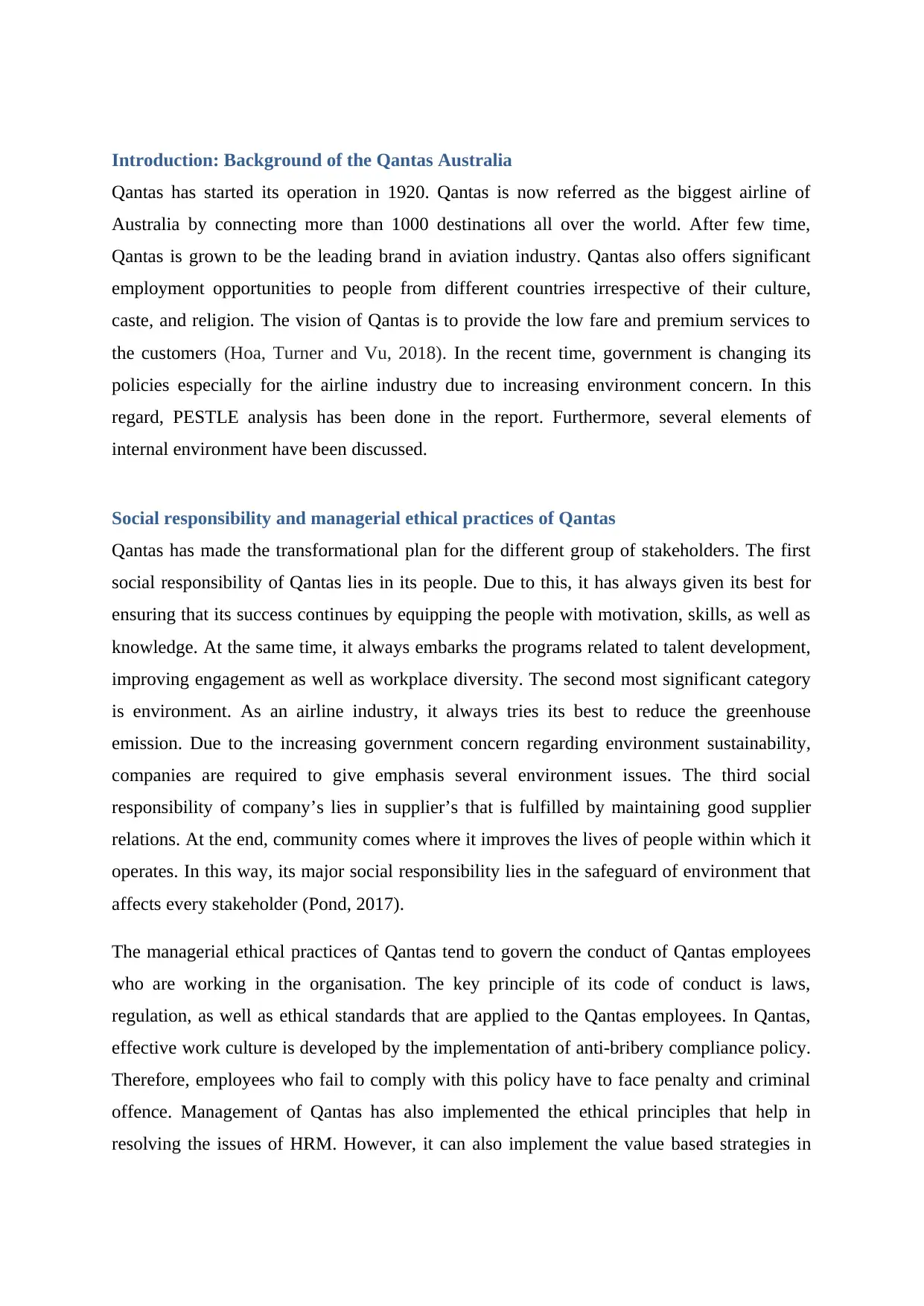
Introduction: Background of the Qantas Australia
Qantas has started its operation in 1920. Qantas is now referred as the biggest airline of
Australia by connecting more than 1000 destinations all over the world. After few time,
Qantas is grown to be the leading brand in aviation industry. Qantas also offers significant
employment opportunities to people from different countries irrespective of their culture,
caste, and religion. The vision of Qantas is to provide the low fare and premium services to
the customers (Hoa, Turner and Vu, 2018). In the recent time, government is changing its
policies especially for the airline industry due to increasing environment concern. In this
regard, PESTLE analysis has been done in the report. Furthermore, several elements of
internal environment have been discussed.
Social responsibility and managerial ethical practices of Qantas
Qantas has made the transformational plan for the different group of stakeholders. The first
social responsibility of Qantas lies in its people. Due to this, it has always given its best for
ensuring that its success continues by equipping the people with motivation, skills, as well as
knowledge. At the same time, it always embarks the programs related to talent development,
improving engagement as well as workplace diversity. The second most significant category
is environment. As an airline industry, it always tries its best to reduce the greenhouse
emission. Due to the increasing government concern regarding environment sustainability,
companies are required to give emphasis several environment issues. The third social
responsibility of company’s lies in supplier’s that is fulfilled by maintaining good supplier
relations. At the end, community comes where it improves the lives of people within which it
operates. In this way, its major social responsibility lies in the safeguard of environment that
affects every stakeholder (Pond, 2017).
The managerial ethical practices of Qantas tend to govern the conduct of Qantas employees
who are working in the organisation. The key principle of its code of conduct is laws,
regulation, as well as ethical standards that are applied to the Qantas employees. In Qantas,
effective work culture is developed by the implementation of anti-bribery compliance policy.
Therefore, employees who fail to comply with this policy have to face penalty and criminal
offence. Management of Qantas has also implemented the ethical principles that help in
resolving the issues of HRM. However, it can also implement the value based strategies in
Qantas has started its operation in 1920. Qantas is now referred as the biggest airline of
Australia by connecting more than 1000 destinations all over the world. After few time,
Qantas is grown to be the leading brand in aviation industry. Qantas also offers significant
employment opportunities to people from different countries irrespective of their culture,
caste, and religion. The vision of Qantas is to provide the low fare and premium services to
the customers (Hoa, Turner and Vu, 2018). In the recent time, government is changing its
policies especially for the airline industry due to increasing environment concern. In this
regard, PESTLE analysis has been done in the report. Furthermore, several elements of
internal environment have been discussed.
Social responsibility and managerial ethical practices of Qantas
Qantas has made the transformational plan for the different group of stakeholders. The first
social responsibility of Qantas lies in its people. Due to this, it has always given its best for
ensuring that its success continues by equipping the people with motivation, skills, as well as
knowledge. At the same time, it always embarks the programs related to talent development,
improving engagement as well as workplace diversity. The second most significant category
is environment. As an airline industry, it always tries its best to reduce the greenhouse
emission. Due to the increasing government concern regarding environment sustainability,
companies are required to give emphasis several environment issues. The third social
responsibility of company’s lies in supplier’s that is fulfilled by maintaining good supplier
relations. At the end, community comes where it improves the lives of people within which it
operates. In this way, its major social responsibility lies in the safeguard of environment that
affects every stakeholder (Pond, 2017).
The managerial ethical practices of Qantas tend to govern the conduct of Qantas employees
who are working in the organisation. The key principle of its code of conduct is laws,
regulation, as well as ethical standards that are applied to the Qantas employees. In Qantas,
effective work culture is developed by the implementation of anti-bribery compliance policy.
Therefore, employees who fail to comply with this policy have to face penalty and criminal
offence. Management of Qantas has also implemented the ethical principles that help in
resolving the issues of HRM. However, it can also implement the value based strategies in
⊘ This is a preview!⊘
Do you want full access?
Subscribe today to unlock all pages.

Trusted by 1+ million students worldwide

order to handle the issues related to social environment and politics in organisation (White,
2018).
Pestle analysis of Qantas Australia
Political factors: It is true that government support is quite significant for every company to
grow in the competitive pressure. It is found that Qantas was going through the tough time in
year 2014 when it asked for the debt guarantee from government but eventually it was
refused. In spite of this, Qantas got the freedom in amendment form to Qantas Sale Act. This
allowed Qantas to bring the outside shareholders (Baxter, Srisaeng and Wild, 2018). At the
same time, China and Australia has also signed the open skies pact in the year 2016 that
helped in removing the entire capacity restriction between two countries. Furthermore, 2017
has been declared as the Australia and China year of tourism.
Economic factors: It is found that the liberal policy has hurt the growth of domestic aviation
industry. It is because it led to the surge in the outbound travel as compare to the expected
influx of the tourist. Qantas has also stated that the government strategy of allowing the air
capacity has cost the national economy. In addition to this, it is found that Qantas new profit
has decline due to the higher cost of fuel. For Qantas, fuel is the biggest success factor. CEO
of Qantas named Alan Joyce stated that it is heavily impacted due to the higher cost of fuel.
As per the recent report, it is found that Qantas Airways annual net profit fell by 6.5 per cent.
It has gained the lower profit due to weaker Australian dollar and higher prices of oil
(Trischler and Lohmann, 2018).
Social factors: Qantas Airlines operates in more than 40 countries by serving to around 1000
destinations across the world. Qantas accommodate more than 40 million passengers every
year. Its effective and customised customer service is helping it in building the brand loyalty.
Due to its string brand image, it tends to enjoy the wide public support, trust as well as local
customer base.
Technological factors: In the recent time, technological innovation plays a significant role in
every organisation. Huge investment is done in the aviation sector to provide the best and
world class experience to the customers. Qantas airline is also using best technology such as
access to the best and superior lounge, Wi-Fi facility, prior check-in as well as stan steaming
in the flights of Qantas.
2018).
Pestle analysis of Qantas Australia
Political factors: It is true that government support is quite significant for every company to
grow in the competitive pressure. It is found that Qantas was going through the tough time in
year 2014 when it asked for the debt guarantee from government but eventually it was
refused. In spite of this, Qantas got the freedom in amendment form to Qantas Sale Act. This
allowed Qantas to bring the outside shareholders (Baxter, Srisaeng and Wild, 2018). At the
same time, China and Australia has also signed the open skies pact in the year 2016 that
helped in removing the entire capacity restriction between two countries. Furthermore, 2017
has been declared as the Australia and China year of tourism.
Economic factors: It is found that the liberal policy has hurt the growth of domestic aviation
industry. It is because it led to the surge in the outbound travel as compare to the expected
influx of the tourist. Qantas has also stated that the government strategy of allowing the air
capacity has cost the national economy. In addition to this, it is found that Qantas new profit
has decline due to the higher cost of fuel. For Qantas, fuel is the biggest success factor. CEO
of Qantas named Alan Joyce stated that it is heavily impacted due to the higher cost of fuel.
As per the recent report, it is found that Qantas Airways annual net profit fell by 6.5 per cent.
It has gained the lower profit due to weaker Australian dollar and higher prices of oil
(Trischler and Lohmann, 2018).
Social factors: Qantas Airlines operates in more than 40 countries by serving to around 1000
destinations across the world. Qantas accommodate more than 40 million passengers every
year. Its effective and customised customer service is helping it in building the brand loyalty.
Due to its string brand image, it tends to enjoy the wide public support, trust as well as local
customer base.
Technological factors: In the recent time, technological innovation plays a significant role in
every organisation. Huge investment is done in the aviation sector to provide the best and
world class experience to the customers. Qantas airline is also using best technology such as
access to the best and superior lounge, Wi-Fi facility, prior check-in as well as stan steaming
in the flights of Qantas.
Paraphrase This Document
Need a fresh take? Get an instant paraphrase of this document with our AI Paraphraser
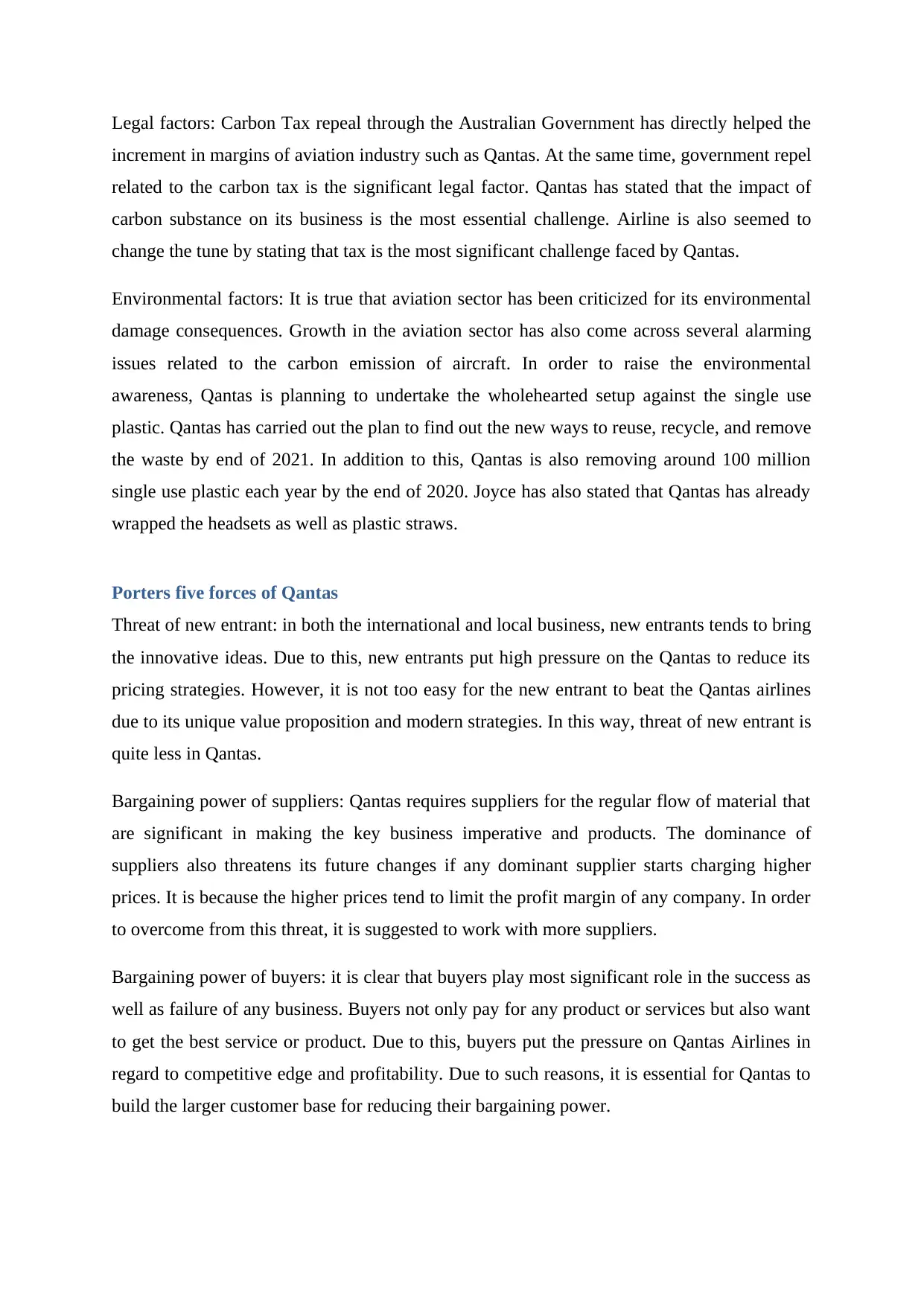
Legal factors: Carbon Tax repeal through the Australian Government has directly helped the
increment in margins of aviation industry such as Qantas. At the same time, government repel
related to the carbon tax is the significant legal factor. Qantas has stated that the impact of
carbon substance on its business is the most essential challenge. Airline is also seemed to
change the tune by stating that tax is the most significant challenge faced by Qantas.
Environmental factors: It is true that aviation sector has been criticized for its environmental
damage consequences. Growth in the aviation sector has also come across several alarming
issues related to the carbon emission of aircraft. In order to raise the environmental
awareness, Qantas is planning to undertake the wholehearted setup against the single use
plastic. Qantas has carried out the plan to find out the new ways to reuse, recycle, and remove
the waste by end of 2021. In addition to this, Qantas is also removing around 100 million
single use plastic each year by the end of 2020. Joyce has also stated that Qantas has already
wrapped the headsets as well as plastic straws.
Porters five forces of Qantas
Threat of new entrant: in both the international and local business, new entrants tends to bring
the innovative ideas. Due to this, new entrants put high pressure on the Qantas to reduce its
pricing strategies. However, it is not too easy for the new entrant to beat the Qantas airlines
due to its unique value proposition and modern strategies. In this way, threat of new entrant is
quite less in Qantas.
Bargaining power of suppliers: Qantas requires suppliers for the regular flow of material that
are significant in making the key business imperative and products. The dominance of
suppliers also threatens its future changes if any dominant supplier starts charging higher
prices. It is because the higher prices tend to limit the profit margin of any company. In order
to overcome from this threat, it is suggested to work with more suppliers.
Bargaining power of buyers: it is clear that buyers play most significant role in the success as
well as failure of any business. Buyers not only pay for any product or services but also want
to get the best service or product. Due to this, buyers put the pressure on Qantas Airlines in
regard to competitive edge and profitability. Due to such reasons, it is essential for Qantas to
build the larger customer base for reducing their bargaining power.
increment in margins of aviation industry such as Qantas. At the same time, government repel
related to the carbon tax is the significant legal factor. Qantas has stated that the impact of
carbon substance on its business is the most essential challenge. Airline is also seemed to
change the tune by stating that tax is the most significant challenge faced by Qantas.
Environmental factors: It is true that aviation sector has been criticized for its environmental
damage consequences. Growth in the aviation sector has also come across several alarming
issues related to the carbon emission of aircraft. In order to raise the environmental
awareness, Qantas is planning to undertake the wholehearted setup against the single use
plastic. Qantas has carried out the plan to find out the new ways to reuse, recycle, and remove
the waste by end of 2021. In addition to this, Qantas is also removing around 100 million
single use plastic each year by the end of 2020. Joyce has also stated that Qantas has already
wrapped the headsets as well as plastic straws.
Porters five forces of Qantas
Threat of new entrant: in both the international and local business, new entrants tends to bring
the innovative ideas. Due to this, new entrants put high pressure on the Qantas to reduce its
pricing strategies. However, it is not too easy for the new entrant to beat the Qantas airlines
due to its unique value proposition and modern strategies. In this way, threat of new entrant is
quite less in Qantas.
Bargaining power of suppliers: Qantas requires suppliers for the regular flow of material that
are significant in making the key business imperative and products. The dominance of
suppliers also threatens its future changes if any dominant supplier starts charging higher
prices. It is because the higher prices tend to limit the profit margin of any company. In order
to overcome from this threat, it is suggested to work with more suppliers.
Bargaining power of buyers: it is clear that buyers play most significant role in the success as
well as failure of any business. Buyers not only pay for any product or services but also want
to get the best service or product. Due to this, buyers put the pressure on Qantas Airlines in
regard to competitive edge and profitability. Due to such reasons, it is essential for Qantas to
build the larger customer base for reducing their bargaining power.
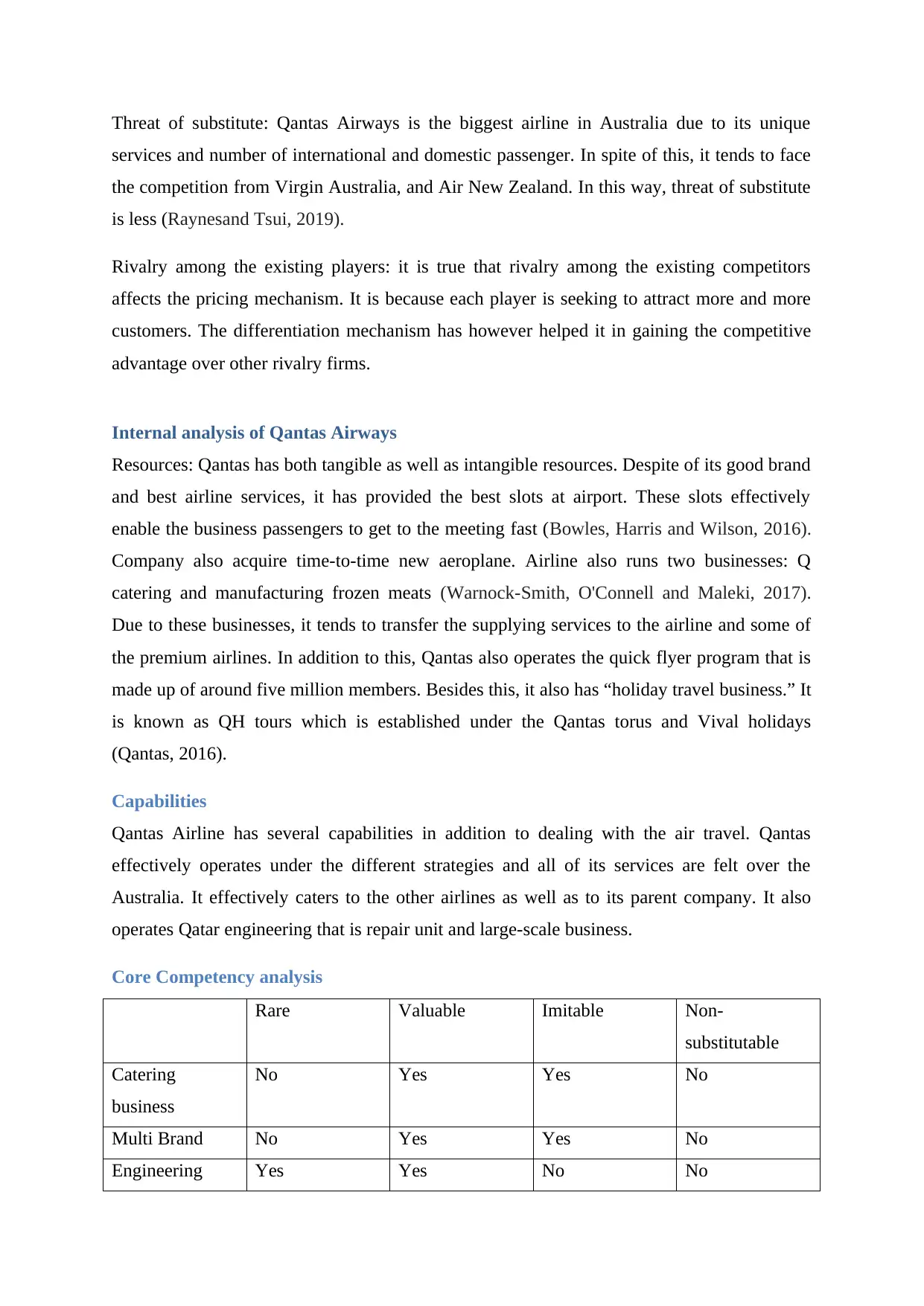
Threat of substitute: Qantas Airways is the biggest airline in Australia due to its unique
services and number of international and domestic passenger. In spite of this, it tends to face
the competition from Virgin Australia, and Air New Zealand. In this way, threat of substitute
is less (Raynesand Tsui, 2019).
Rivalry among the existing players: it is true that rivalry among the existing competitors
affects the pricing mechanism. It is because each player is seeking to attract more and more
customers. The differentiation mechanism has however helped it in gaining the competitive
advantage over other rivalry firms.
Internal analysis of Qantas Airways
Resources: Qantas has both tangible as well as intangible resources. Despite of its good brand
and best airline services, it has provided the best slots at airport. These slots effectively
enable the business passengers to get to the meeting fast (Bowles, Harris and Wilson, 2016).
Company also acquire time-to-time new aeroplane. Airline also runs two businesses: Q
catering and manufacturing frozen meats (Warnock-Smith, O'Connell and Maleki, 2017).
Due to these businesses, it tends to transfer the supplying services to the airline and some of
the premium airlines. In addition to this, Qantas also operates the quick flyer program that is
made up of around five million members. Besides this, it also has “holiday travel business.” It
is known as QH tours which is established under the Qantas torus and Vival holidays
(Qantas, 2016).
Capabilities
Qantas Airline has several capabilities in addition to dealing with the air travel. Qantas
effectively operates under the different strategies and all of its services are felt over the
Australia. It effectively caters to the other airlines as well as to its parent company. It also
operates Qatar engineering that is repair unit and large-scale business.
Core Competency analysis
Rare Valuable Imitable Non-
substitutable
Catering
business
No Yes Yes No
Multi Brand No Yes Yes No
Engineering Yes Yes No No
services and number of international and domestic passenger. In spite of this, it tends to face
the competition from Virgin Australia, and Air New Zealand. In this way, threat of substitute
is less (Raynesand Tsui, 2019).
Rivalry among the existing players: it is true that rivalry among the existing competitors
affects the pricing mechanism. It is because each player is seeking to attract more and more
customers. The differentiation mechanism has however helped it in gaining the competitive
advantage over other rivalry firms.
Internal analysis of Qantas Airways
Resources: Qantas has both tangible as well as intangible resources. Despite of its good brand
and best airline services, it has provided the best slots at airport. These slots effectively
enable the business passengers to get to the meeting fast (Bowles, Harris and Wilson, 2016).
Company also acquire time-to-time new aeroplane. Airline also runs two businesses: Q
catering and manufacturing frozen meats (Warnock-Smith, O'Connell and Maleki, 2017).
Due to these businesses, it tends to transfer the supplying services to the airline and some of
the premium airlines. In addition to this, Qantas also operates the quick flyer program that is
made up of around five million members. Besides this, it also has “holiday travel business.” It
is known as QH tours which is established under the Qantas torus and Vival holidays
(Qantas, 2016).
Capabilities
Qantas Airline has several capabilities in addition to dealing with the air travel. Qantas
effectively operates under the different strategies and all of its services are felt over the
Australia. It effectively caters to the other airlines as well as to its parent company. It also
operates Qatar engineering that is repair unit and large-scale business.
Core Competency analysis
Rare Valuable Imitable Non-
substitutable
Catering
business
No Yes Yes No
Multi Brand No Yes Yes No
Engineering Yes Yes No No
⊘ This is a preview!⊘
Do you want full access?
Subscribe today to unlock all pages.

Trusted by 1+ million students worldwide

New airplanes No Yes Yes No
Excellent airport
spots
Yes Yes Yes Yes
Brand image No Yes Yes Yes
Value Chain analysis
Significant strategic tool directly explains the activities carried out by the organisation for
delivering the valuable product as well as services to the customers. It mainly includes the
support and primary activities. Primary activities include the operations, inbound logistics,
sales, marketing, outbound services and technology. In relation to Qantas, airlines provide the
air services. Therefore, inbound logistics are the passengers who travel with the airline
(Rissiek and Bardram, 2017).Operation activity include the luggage aircraft movement,
security check of passengers as well as passenger’s assistance with the aircraft. IN order to
perform the primary activities, support activities play most significant role because
technology plays the most significant role throughout the whole travelling process. In
addition to this, airline also does investment in the research and development activities
(Hammoud, Tawfik and Fahmy, 2018).
Competitive advantage
Data, brand, and technology are the most significant element that provides the competitive
advantage to a company. Qantas transparency with each of its stakeholder as provided the
competitive advantage to it. This trust has also enabled it to establish new growth businesses
that will help it in getting more earnings at the time of its downturn. From the perspective of
customer also, it has created several new ways to earn points so that those points can be used
by it during holidays. Qantas has stated that innovation will always be the significant element
in driving long-term competitive advantage. for example: it tends to provide the personalised
experience and service to its customers such as future fit baggage, invisible check-in, and
customer self-service. At the same time, it also provides the retail, data, marketing and
financial services (Winzar, Baumann and Chu, 2018).
Strategic competitiveness
It is found that Qantas has several business and corporate level strategies that helps it in
achieving the competitive advantage. In every strategy, it tends to achieve the operational
efficiency through integration of simplicity. Its most of the strategy also achieve the safety in
Excellent airport
spots
Yes Yes Yes Yes
Brand image No Yes Yes Yes
Value Chain analysis
Significant strategic tool directly explains the activities carried out by the organisation for
delivering the valuable product as well as services to the customers. It mainly includes the
support and primary activities. Primary activities include the operations, inbound logistics,
sales, marketing, outbound services and technology. In relation to Qantas, airlines provide the
air services. Therefore, inbound logistics are the passengers who travel with the airline
(Rissiek and Bardram, 2017).Operation activity include the luggage aircraft movement,
security check of passengers as well as passenger’s assistance with the aircraft. IN order to
perform the primary activities, support activities play most significant role because
technology plays the most significant role throughout the whole travelling process. In
addition to this, airline also does investment in the research and development activities
(Hammoud, Tawfik and Fahmy, 2018).
Competitive advantage
Data, brand, and technology are the most significant element that provides the competitive
advantage to a company. Qantas transparency with each of its stakeholder as provided the
competitive advantage to it. This trust has also enabled it to establish new growth businesses
that will help it in getting more earnings at the time of its downturn. From the perspective of
customer also, it has created several new ways to earn points so that those points can be used
by it during holidays. Qantas has stated that innovation will always be the significant element
in driving long-term competitive advantage. for example: it tends to provide the personalised
experience and service to its customers such as future fit baggage, invisible check-in, and
customer self-service. At the same time, it also provides the retail, data, marketing and
financial services (Winzar, Baumann and Chu, 2018).
Strategic competitiveness
It is found that Qantas has several business and corporate level strategies that helps it in
achieving the competitive advantage. In every strategy, it tends to achieve the operational
efficiency through integration of simplicity. Its most of the strategy also achieve the safety in
Paraphrase This Document
Need a fresh take? Get an instant paraphrase of this document with our AI Paraphraser
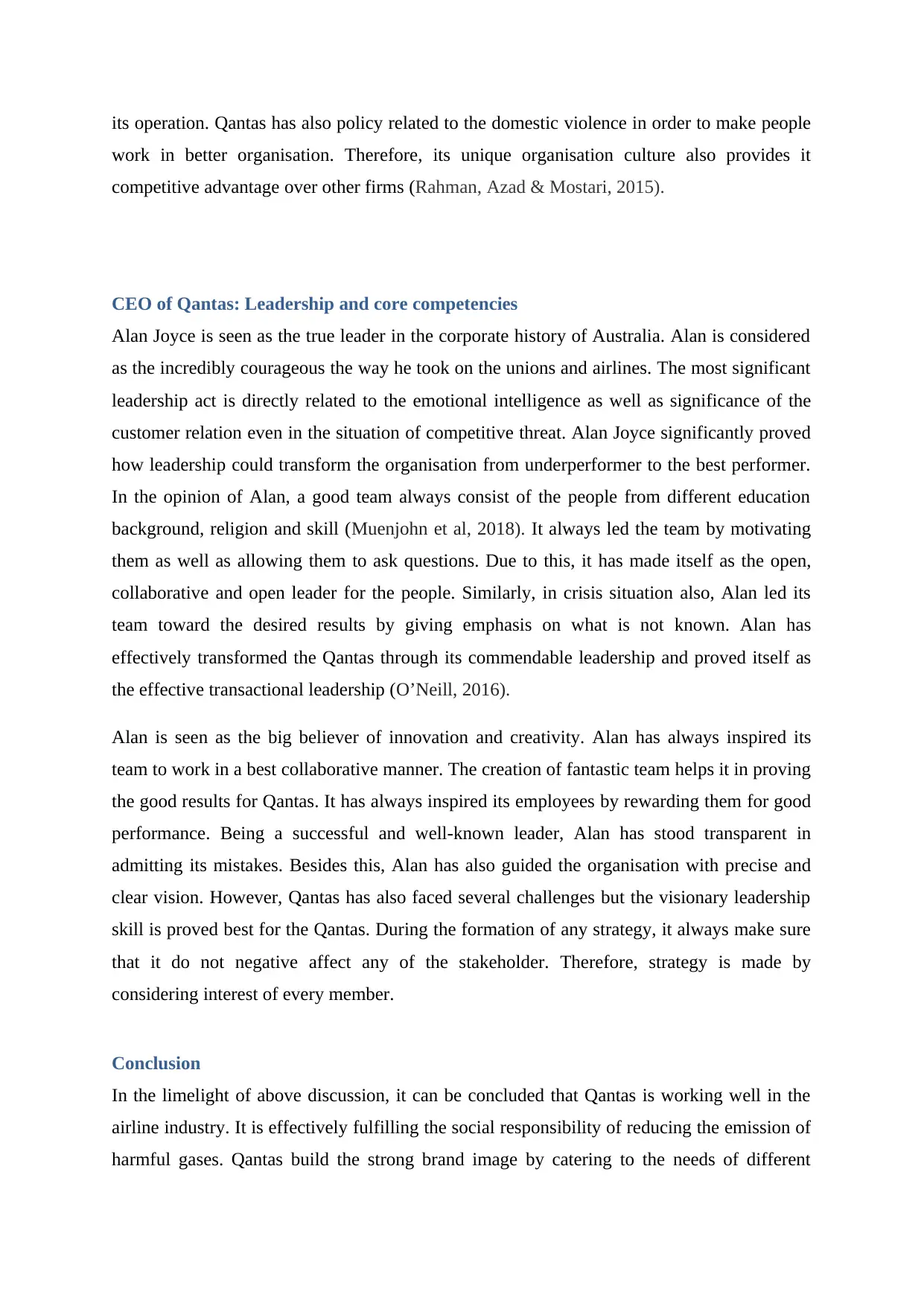
its operation. Qantas has also policy related to the domestic violence in order to make people
work in better organisation. Therefore, its unique organisation culture also provides it
competitive advantage over other firms (Rahman, Azad & Mostari, 2015).
CEO of Qantas: Leadership and core competencies
Alan Joyce is seen as the true leader in the corporate history of Australia. Alan is considered
as the incredibly courageous the way he took on the unions and airlines. The most significant
leadership act is directly related to the emotional intelligence as well as significance of the
customer relation even in the situation of competitive threat. Alan Joyce significantly proved
how leadership could transform the organisation from underperformer to the best performer.
In the opinion of Alan, a good team always consist of the people from different education
background, religion and skill (Muenjohn et al, 2018). It always led the team by motivating
them as well as allowing them to ask questions. Due to this, it has made itself as the open,
collaborative and open leader for the people. Similarly, in crisis situation also, Alan led its
team toward the desired results by giving emphasis on what is not known. Alan has
effectively transformed the Qantas through its commendable leadership and proved itself as
the effective transactional leadership (O’Neill, 2016).
Alan is seen as the big believer of innovation and creativity. Alan has always inspired its
team to work in a best collaborative manner. The creation of fantastic team helps it in proving
the good results for Qantas. It has always inspired its employees by rewarding them for good
performance. Being a successful and well-known leader, Alan has stood transparent in
admitting its mistakes. Besides this, Alan has also guided the organisation with precise and
clear vision. However, Qantas has also faced several challenges but the visionary leadership
skill is proved best for the Qantas. During the formation of any strategy, it always make sure
that it do not negative affect any of the stakeholder. Therefore, strategy is made by
considering interest of every member.
Conclusion
In the limelight of above discussion, it can be concluded that Qantas is working well in the
airline industry. It is effectively fulfilling the social responsibility of reducing the emission of
harmful gases. Qantas build the strong brand image by catering to the needs of different
work in better organisation. Therefore, its unique organisation culture also provides it
competitive advantage over other firms (Rahman, Azad & Mostari, 2015).
CEO of Qantas: Leadership and core competencies
Alan Joyce is seen as the true leader in the corporate history of Australia. Alan is considered
as the incredibly courageous the way he took on the unions and airlines. The most significant
leadership act is directly related to the emotional intelligence as well as significance of the
customer relation even in the situation of competitive threat. Alan Joyce significantly proved
how leadership could transform the organisation from underperformer to the best performer.
In the opinion of Alan, a good team always consist of the people from different education
background, religion and skill (Muenjohn et al, 2018). It always led the team by motivating
them as well as allowing them to ask questions. Due to this, it has made itself as the open,
collaborative and open leader for the people. Similarly, in crisis situation also, Alan led its
team toward the desired results by giving emphasis on what is not known. Alan has
effectively transformed the Qantas through its commendable leadership and proved itself as
the effective transactional leadership (O’Neill, 2016).
Alan is seen as the big believer of innovation and creativity. Alan has always inspired its
team to work in a best collaborative manner. The creation of fantastic team helps it in proving
the good results for Qantas. It has always inspired its employees by rewarding them for good
performance. Being a successful and well-known leader, Alan has stood transparent in
admitting its mistakes. Besides this, Alan has also guided the organisation with precise and
clear vision. However, Qantas has also faced several challenges but the visionary leadership
skill is proved best for the Qantas. During the formation of any strategy, it always make sure
that it do not negative affect any of the stakeholder. Therefore, strategy is made by
considering interest of every member.
Conclusion
In the limelight of above discussion, it can be concluded that Qantas is working well in the
airline industry. It is effectively fulfilling the social responsibility of reducing the emission of
harmful gases. Qantas build the strong brand image by catering to the needs of different
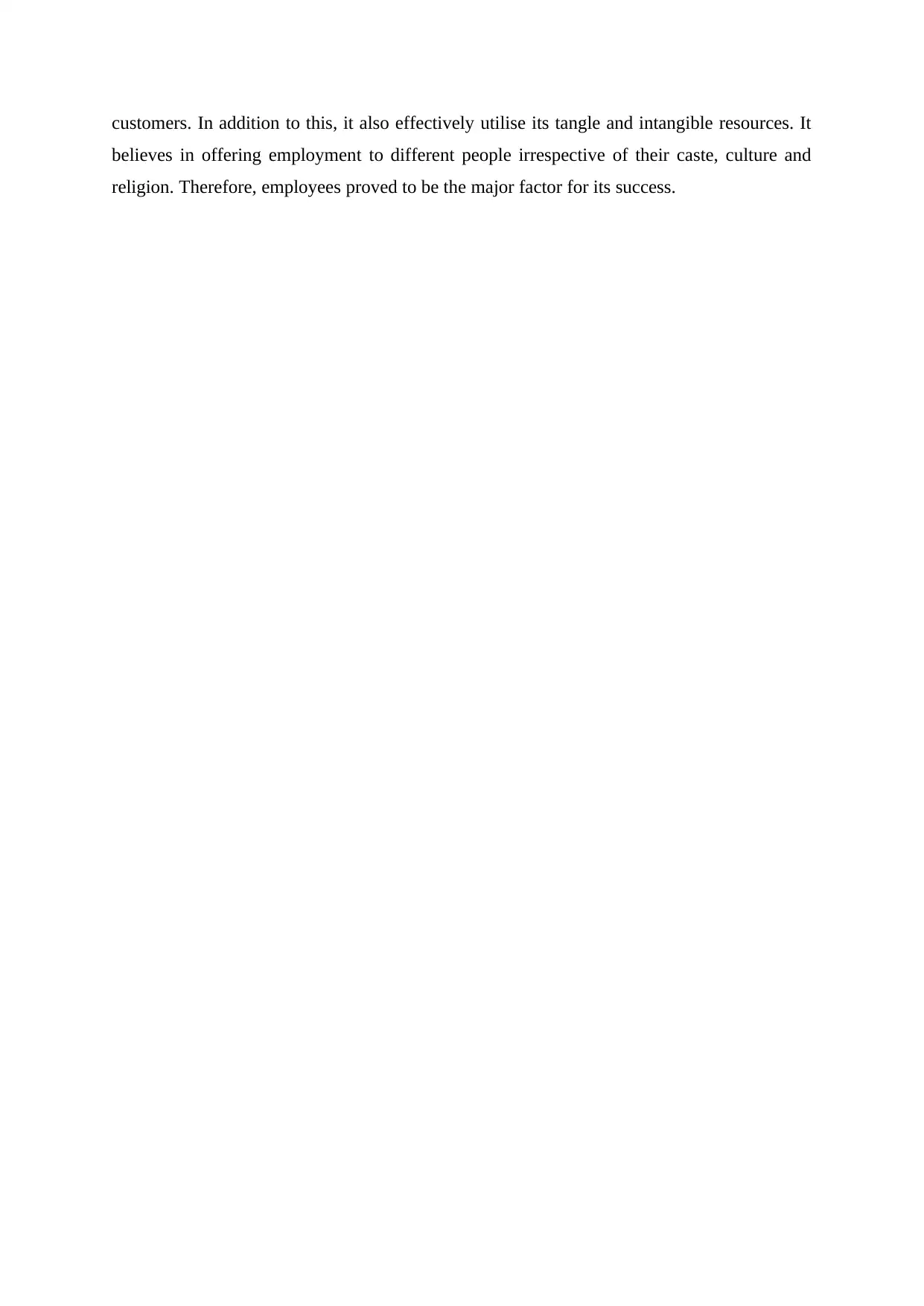
customers. In addition to this, it also effectively utilise its tangle and intangible resources. It
believes in offering employment to different people irrespective of their caste, culture and
religion. Therefore, employees proved to be the major factor for its success.
believes in offering employment to different people irrespective of their caste, culture and
religion. Therefore, employees proved to be the major factor for its success.
⊘ This is a preview!⊘
Do you want full access?
Subscribe today to unlock all pages.

Trusted by 1+ million students worldwide

References
Baxter, G., Srisaeng, P. and Wild, G., 2018. The role of freighter aircraft in a full-service
network airline air freight services: The case of Qantas Freight. MAD-Magazine of Aviation
Development, 6(4), pp.28-51.
Bowles, M.S., Harris, J. and Wilson, P.T., 2016. Leadership capabilities for agile
organisations: mining leadership frameworks using latent dirichlet allocation. International
Journal of Business and Social Science, 7(11), pp.10-23.
Hammoud, G.A., Tawfik, H.F. and Fahmy, R.S., 2018. Development of Airlines' Distribution
Capabilities. Journal of Tourism and Hospitality Management, 6(1), pp.66-80.
Muenjohn, N., McMurray, A., Fernando, M., Hunt, J., Fitzgerald, M., McKenna, B., Intezari,
A., Bankins, S. and Waterhouse, J., 2018. Leadership. Cambridge University Press.
O’Neill, R., 2016. The importance of a diverse and culturally competent
workforce. Busidate, 24(3), p.9.
Pond, S.M., 2017. Advancing Toward Alternative Aviation Fuel Production in
Australia. Industrial Biotechnology, 13(2), pp.69-71.
Qantas Group. 2016. Our Company. Retrieved from Qantas Group:
https://www.qantas.com/au/en.html
Rahman, K., Azad, S., & Mostari, S. (2015). A Competitive Analysis of Airline Industry: A
Case Study on Biman Bangladesh Airlines. Journal of Business and management, 17(4), 23-
33.
Raynes, C. and Tsui, K.W.H., 2019. Review of Airline-within-Airline strategy: Case studies
of the Singapore Airlines Group and Qantas Group. Case Studies on Transport Policy, 7(1),
pp.150-165.
Rissiek, J. and Bardram, M., 2017. The Material Value Chain Services in Commercial
Aviation. In Supply Chain Integration Challenges in Commercial Aerospace (pp. 249-265).
Springer, Cham.
Baxter, G., Srisaeng, P. and Wild, G., 2018. The role of freighter aircraft in a full-service
network airline air freight services: The case of Qantas Freight. MAD-Magazine of Aviation
Development, 6(4), pp.28-51.
Bowles, M.S., Harris, J. and Wilson, P.T., 2016. Leadership capabilities for agile
organisations: mining leadership frameworks using latent dirichlet allocation. International
Journal of Business and Social Science, 7(11), pp.10-23.
Hammoud, G.A., Tawfik, H.F. and Fahmy, R.S., 2018. Development of Airlines' Distribution
Capabilities. Journal of Tourism and Hospitality Management, 6(1), pp.66-80.
Muenjohn, N., McMurray, A., Fernando, M., Hunt, J., Fitzgerald, M., McKenna, B., Intezari,
A., Bankins, S. and Waterhouse, J., 2018. Leadership. Cambridge University Press.
O’Neill, R., 2016. The importance of a diverse and culturally competent
workforce. Busidate, 24(3), p.9.
Pond, S.M., 2017. Advancing Toward Alternative Aviation Fuel Production in
Australia. Industrial Biotechnology, 13(2), pp.69-71.
Qantas Group. 2016. Our Company. Retrieved from Qantas Group:
https://www.qantas.com/au/en.html
Rahman, K., Azad, S., & Mostari, S. (2015). A Competitive Analysis of Airline Industry: A
Case Study on Biman Bangladesh Airlines. Journal of Business and management, 17(4), 23-
33.
Raynes, C. and Tsui, K.W.H., 2019. Review of Airline-within-Airline strategy: Case studies
of the Singapore Airlines Group and Qantas Group. Case Studies on Transport Policy, 7(1),
pp.150-165.
Rissiek, J. and Bardram, M., 2017. The Material Value Chain Services in Commercial
Aviation. In Supply Chain Integration Challenges in Commercial Aerospace (pp. 249-265).
Springer, Cham.
Paraphrase This Document
Need a fresh take? Get an instant paraphrase of this document with our AI Paraphraser
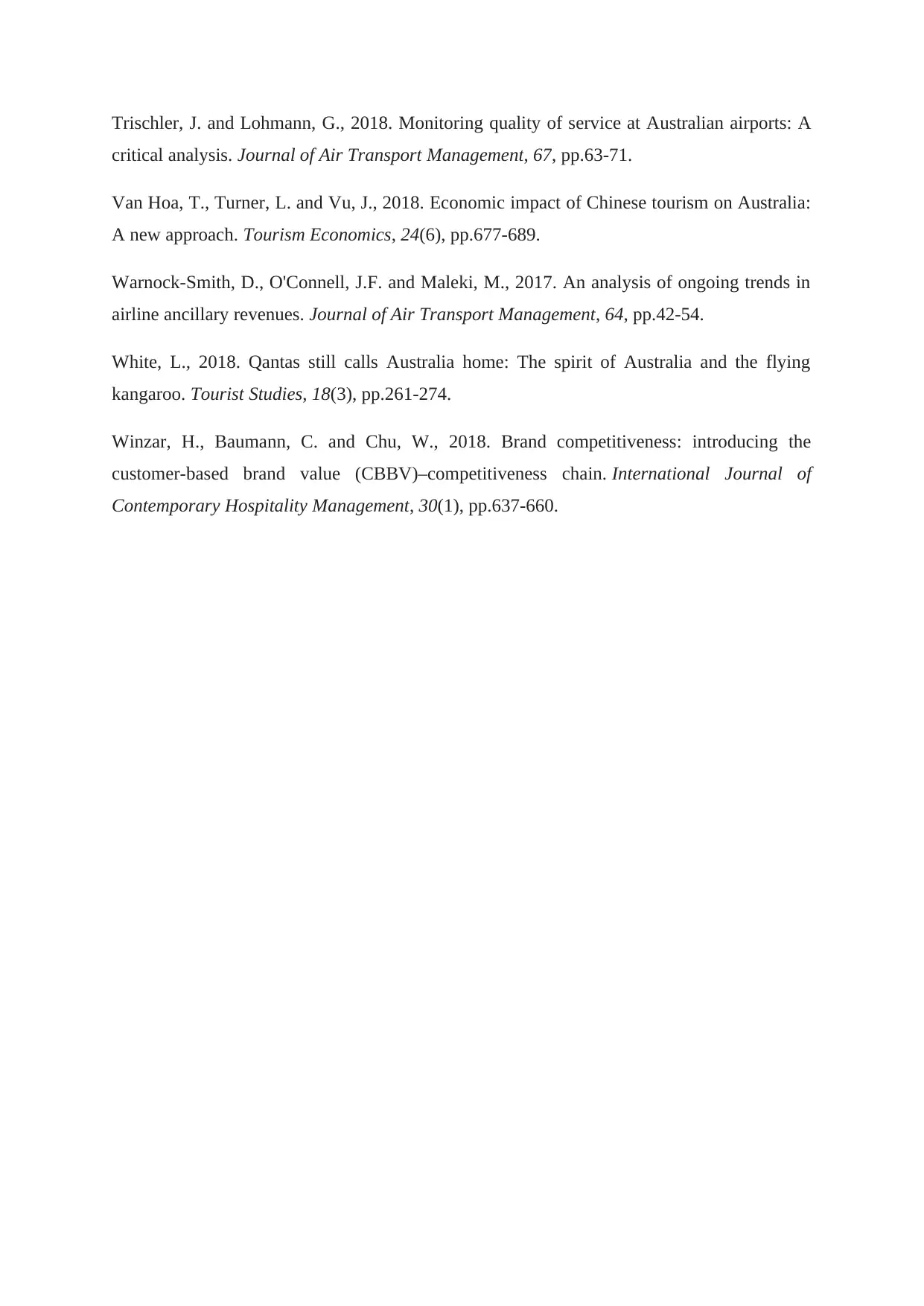
Trischler, J. and Lohmann, G., 2018. Monitoring quality of service at Australian airports: A
critical analysis. Journal of Air Transport Management, 67, pp.63-71.
Van Hoa, T., Turner, L. and Vu, J., 2018. Economic impact of Chinese tourism on Australia:
A new approach. Tourism Economics, 24(6), pp.677-689.
Warnock-Smith, D., O'Connell, J.F. and Maleki, M., 2017. An analysis of ongoing trends in
airline ancillary revenues. Journal of Air Transport Management, 64, pp.42-54.
White, L., 2018. Qantas still calls Australia home: The spirit of Australia and the flying
kangaroo. Tourist Studies, 18(3), pp.261-274.
Winzar, H., Baumann, C. and Chu, W., 2018. Brand competitiveness: introducing the
customer-based brand value (CBBV)–competitiveness chain. International Journal of
Contemporary Hospitality Management, 30(1), pp.637-660.
critical analysis. Journal of Air Transport Management, 67, pp.63-71.
Van Hoa, T., Turner, L. and Vu, J., 2018. Economic impact of Chinese tourism on Australia:
A new approach. Tourism Economics, 24(6), pp.677-689.
Warnock-Smith, D., O'Connell, J.F. and Maleki, M., 2017. An analysis of ongoing trends in
airline ancillary revenues. Journal of Air Transport Management, 64, pp.42-54.
White, L., 2018. Qantas still calls Australia home: The spirit of Australia and the flying
kangaroo. Tourist Studies, 18(3), pp.261-274.
Winzar, H., Baumann, C. and Chu, W., 2018. Brand competitiveness: introducing the
customer-based brand value (CBBV)–competitiveness chain. International Journal of
Contemporary Hospitality Management, 30(1), pp.637-660.
1 out of 11
Related Documents
Your All-in-One AI-Powered Toolkit for Academic Success.
+13062052269
info@desklib.com
Available 24*7 on WhatsApp / Email
![[object Object]](/_next/static/media/star-bottom.7253800d.svg)
Unlock your academic potential
Copyright © 2020–2025 A2Z Services. All Rights Reserved. Developed and managed by ZUCOL.





